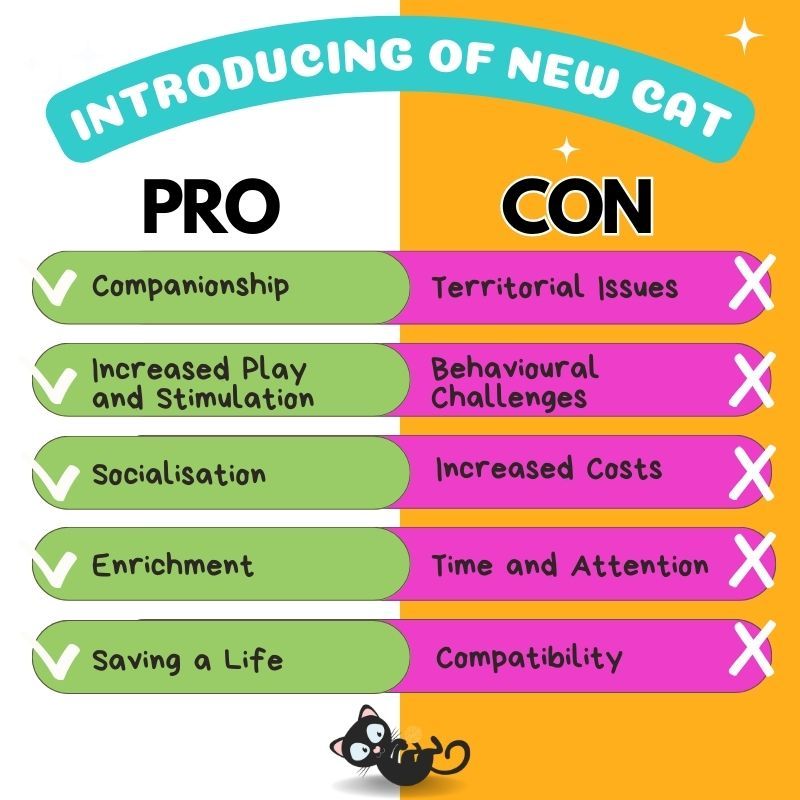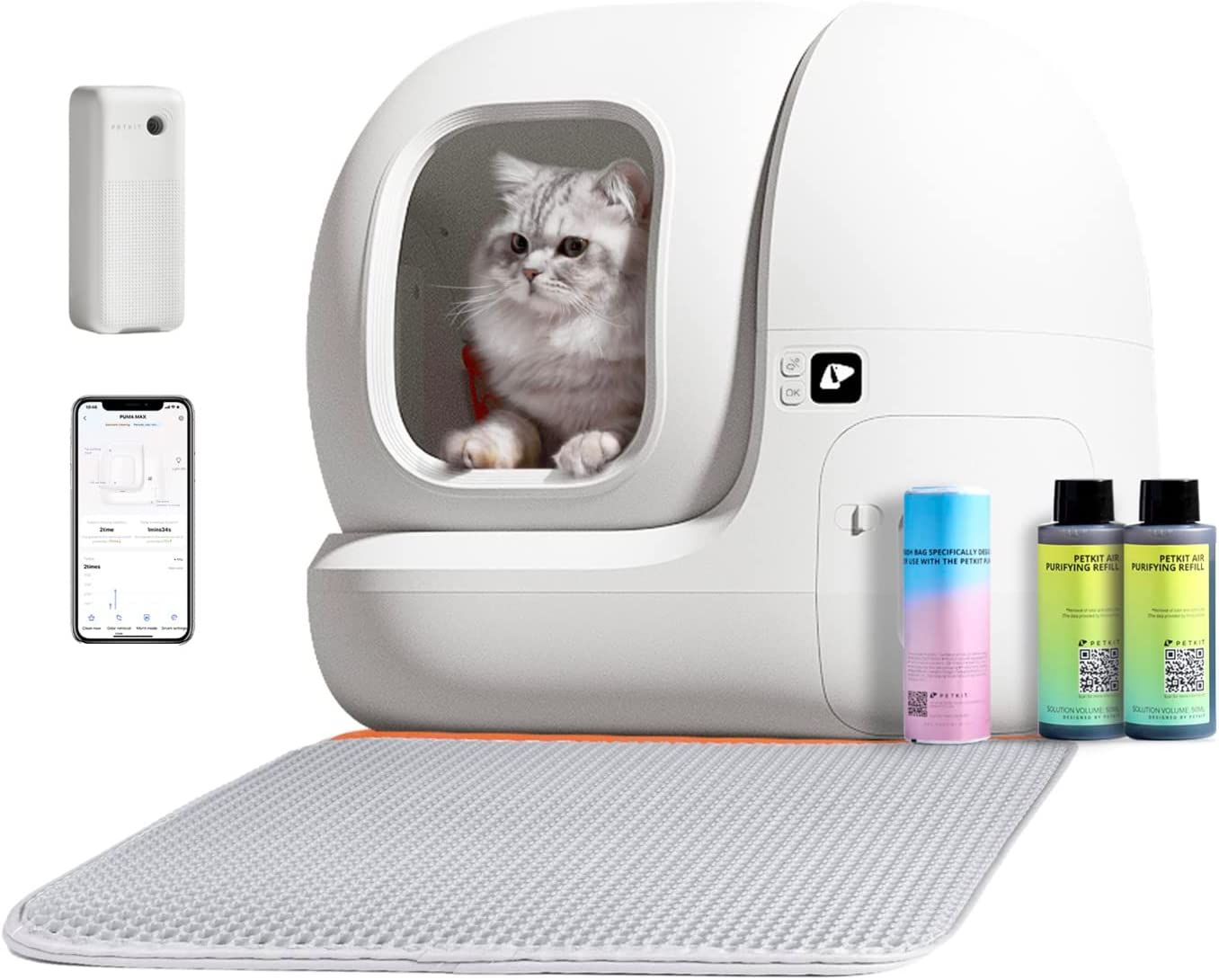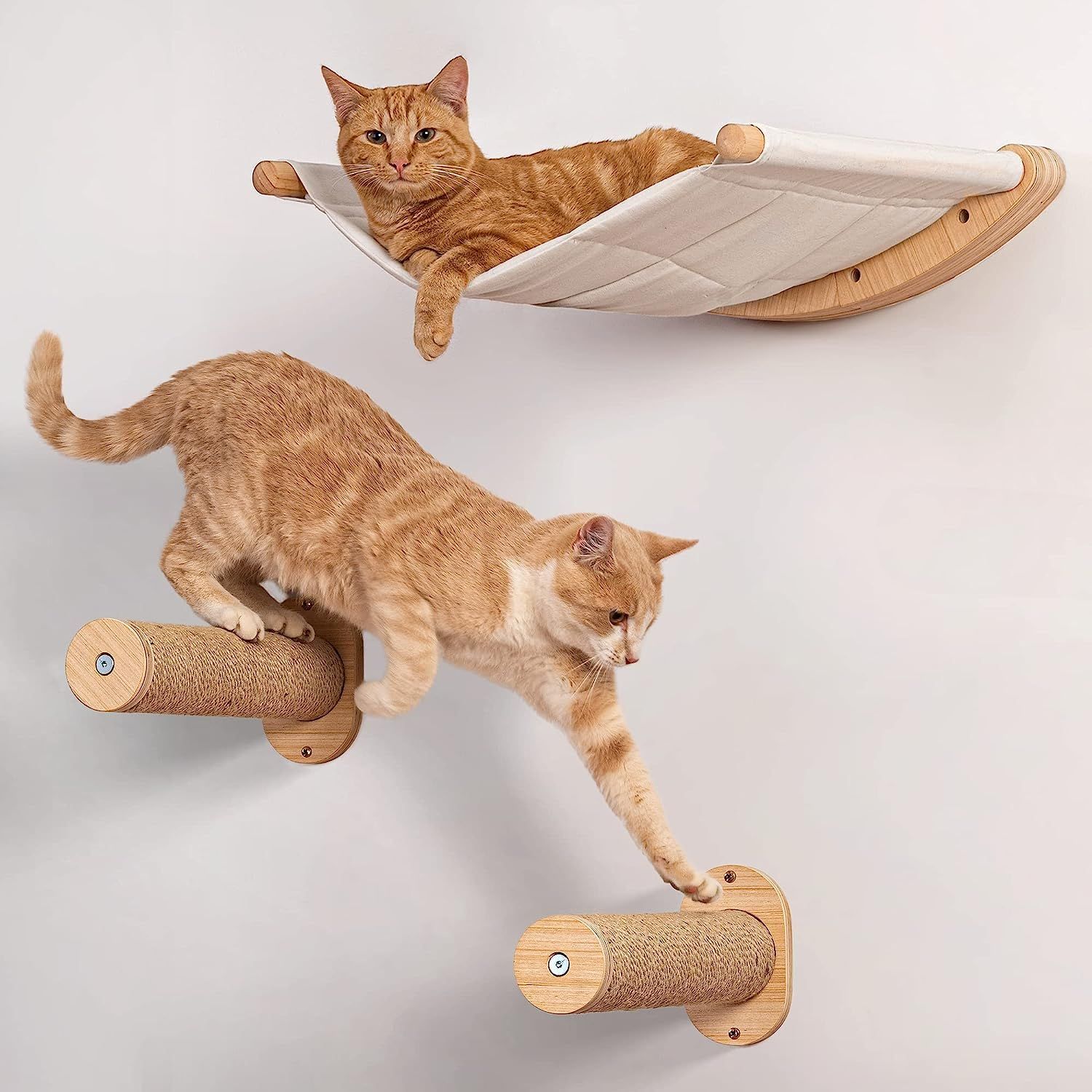PURR-FECT HARMONY
INTRODUCING A NEW CAT TO YOUR HOUSEHOLD
In this blog we will explore answers to some of the most commonly asked questions about Introducing a New Cat to Your Household.
Bringing a new feline friend into your home can be an exciting and heartwarming experience. Whether you're a seasoned cat owner or a first-time feline enthusiast, the prospect of introducing a new cat to your household brings with it a mix of anticipation and joy. However, like any significant change, the process of integrating a new cat into an existing family of pets can be both thrilling and challenging.
Each cat has a unique personality, and their acceptance of a new family member may vary greatly. Some may readily embrace the newcomer with open paws, while others may require more time and patience to adjust to the change. As responsible and caring cat owners, it is crucial to approach the introduction process with thoughtfulness, understanding, and a solid plan in place.
In this blog, we will delve into the delicate art of introducing a new cat to your household, offering valuable insights, expert tips, and practical steps to ensure a smooth and successful transition for all furry family members. Whether you are introducing a second, third, or fourth cat into your home, or even if you're welcoming your very first feline companion, our comprehensive guide will equip you with the knowledge and tools to create an environment of harmony and happiness for every cat under your care.
From deciphering the unique language of feline communication to creating a positive and enriching space for all, we'll cover every aspect of the introduction process. You'll discover the power of scent exchanges, the art of controlled visual contact, and the gradual magic of supervised face-to-face meetings. More than just a mere protocol, we'll explore the emotional and psychological aspects of the introduction, offering valuable insights into understanding your cats' needs and behaviours during this transformative period.
We understand the anxieties and questions that may arise when embarking on this journey. Through our blog, we aim to alleviate your concerns and provide you with a roadmap to navigate the delicate waters of feline introductions. Our goal is to ensure that every cat's journey to forming lasting bonds and cherished companionships is filled with love, patience, and understanding.
So, whether you're preparing to introduce a new playful kitten, a mature cat seeking companionship, or a rescue looking for a forever home, join us on this adventure of unity and coexistence. Let's embark together on a journey that celebrates the magic of cats and the joy of building a strong and loving feline family.
With our expert guidance and your compassionate heart, you'll be well on your way to creating a home filled with purrs, cuddles, and a symphony of contented cat conversations. Let the journey to a purr-fectly harmonious household begin!

5 STEPS TO INTRODUCE A NEW CAT TO YOUR HOUSEHOLD
Introducing a new cat to your household can be a delicate process, especially if you already have other pets. Here are some steps to help make the introduction smoother and increase the chances of your new cat and existing pets getting along:
- Choose the right time: Pick a time when you can dedicate several days to the introduction process. Avoid doing it during hectic periods or when you'll be away for long periods.
- Isolate the new cat: Keep the new cat in a separate room with all the essentials (bed, litter box, food, water) and let them acclimate to the new environment. This allows them to feel safe and reduces the stress of the transition.
- Familiarize scents: Swap bedding and toys between the new cat and your existing pets. This helps them get used to each other's scent, which can make the initial meeting less intimidating.
- Use a gradual introduction: After a few days of separation, start with scent exchanges between the cats. Rub a cloth on one cat and then let the other cat sniff it. This helps them associate the scent with something positive.
- Controlled visual contact: Use a baby gate or cracked door to allow the cats to see each other without direct physical contact. Observe their reactions and body language to gauge their comfort level.
- Short supervised meetings: When both cats seem relaxed with each other's presence, allow them to meet in a controlled environment. Keep these initial meetings short and always supervise them closely. If any signs of aggression or extreme fear are shown, separate them and try again later.
- Positive reinforcement: Reward both cats with treats and affection when they display calm and friendly behaviour around each other. This reinforces positive associations with each other's presence.
- Feeding time: Gradually move their feeding dishes closer to the door or gate separating them, allowing them to associate each other's presence with something enjoyable (food).
- Be patient: The process may take days or even weeks. Be patient and understanding, as some cats take longer to adjust than others.
- Provide individual attention: Ensure that both the new cat and existing pets receive plenty of individual attention, affection, and playtime to prevent feelings of jealousy.
Remember, every cat is unique, and the introduction process may vary. Some cats may become friends quickly, while others may need more time to adjust. Keep a watchful eye on their behaviour and be prepared to adjust the pace of the introduction as needed.
ITEMS FOR SUCCESSFUL INTRODUCTION
As part of a successful introduction, a few items are recommended, and we have sourced some for you throughout this post, but you may also find that a friend or neighbour has some spare items you could borrow.
AUTOMATIC CAT LITTER BOX
Let’s face it cleaning out the litter box isn’t any cat owner's favourite task, so if your budget will allow, why not splash out and let PURA MAX -PETKIT Self Cleaning Cat Litter Tray take care of the mess for you?
This is an extra-large that will easily accommodate a multi-cat household with it’s 76L capacity. It offers Odor Control, APP Control, Safety Protection as well as Mat & Liners.
The is a smart box and the app not only allows you to check on the litter capacity but you can also check each cat’s weight, times of use, duration of use to help keep track of your cat's health.
Automated Pet Feeder
This litter box from Cat Centre Direct is a discrete and modern design, and not only does it offer your cat more privacy, but you will also have less stray litter to clean up 😉
It comes with an activated replaceable charcoal filter to help eliminate odours and It has a small scoop included which is attached under the lid so you won’t misplace. The box hood unclips for cleaning and has a handle for easy carrying.
SHOULD I INTRODUCE A NEW CAT TO OUR HOUSEHOLD - PRO'S & CON'S
Introducing a new cat to your household can have both positive (pro) and negative (con) aspects. Let's explore some of the pros and cons to consider:

PRO'S
- Companionship: Having another cat can provide companionship and alleviate loneliness for both your existing cat and yourself.
- Increased Play and Stimulation: With a new cat around, your current cat may have a playmate, which can help increase their physical activity and mental stimulation.
- Socialisation: Introducing a new cat can help socialize both your current cat and the new addition, making them more comfortable around other animals.
- Enrichment: Multiple cats can engage in interactive play, grooming, and other social behaviours, enriching their lives and providing entertainment.
- Saving a Life: By adopting a new cat from a shelter or rescue, you are giving them a chance at a better life and a loving home.

con'S
- Territorial Issues: Cats can be territorial, and introducing a new cat may lead to territorial conflicts or stress for both the new and current cat.
- Behavioural Challenges: Introducing a new cat can cause behavioural changes in your existing cat, such as increased aggression or anxiety.
- Increased Costs: Owning multiple cats means additional expenses for food, litter, toys, and veterinary care.
- Time and Attention: Having more than one cat requires more time and attention to ensure both receive proper care and individual attention.
- Compatibility: There is a chance that your current cat and the new cat may not get along, leading to ongoing conflicts and difficulties.
In summary, introducing a new cat can bring companionship and increased stimulation to your household, benefiting both your pets and yourself. However, it's essential to be aware of potential territorial issues, behavioural challenges, and the increased responsibility and expenses that come with having multiple cats.
If you are prepared to invest time and effort in facilitating a smooth introduction and addressing any potential conflicts, and if your current living situation and resources allow for another cat, the decision to introduce a new cat can be a rewarding one. Nonetheless, carefully consider the individual dynamics of your household and the needs of your current cat before making a final decision.
FELIWAY OPTIMUM DIFFUSER
Widely considered the best solution for easing cat anxiety, cat conflict and stress in the home. Clinically proven cat behavioural product.
It is backed by over 25 years of science & research into pet welfare. This 30-day refill diffuser contains a brand-new pheromone complex which has been proven to calm cats better than ever.

HOW DO I KNOW IF MY CAT WILL ACCEPT ANOTHER CAT
Determining whether your cat will accept another cat is not always straightforward, as each cat has a unique personality and temperament. However, there are some signs and factors you can consider to gauge the likelihood of a successful introduction:
- Previous Social Interactions: Consider how your cat has interacted with other cats or animals in the past. If they have had positive experiences and seem comfortable around other animals, it's a good indicator that they may accept a new cat.
- Social and Playful Behaviour: Cats that are naturally social, friendly, and playful with other cats are more likely to be open to having a new feline companion.
- Age and Adaptability: Younger cats or kittens tend to be more adaptable and may have an easier time accepting a new cat into the household compared to older, more established cats.
- Experience with Other Cats: If your cat has lived with other cats before and had a positive relationship with them, they may be more receptive to a new feline companion.
- Territorial Tendencies: Consider your cat's territorial instincts. Cats that are highly territorial or have a history of not getting along with other animals may be less accepting of a new cat.
- Body Language and Behaviour: Observe your cat's body language and behaviour when they encounter other cats. Signs of aggression, fear, excessive stress, or avoidance may indicate that they are not ready for another cat.
- Vocalisations: Pay attention to your cat's vocalizations when they encounter other cats. Aggressive vocalizations, growling, or hissing can be signs of resistance to a new cat.
- Current Living Situation: Consider your cat's current living conditions, including available space, resources (food, litter boxes, etc.), and the overall environment. A harmonious home can contribute to successful introductions.
- Gradual Introduction: When introducing a new cat, do so gradually and in a controlled manner. Use scent exchanges, controlled visual contact, and supervised meetings to help your cats adjust to each other's presence.
- Patience and Supervision: Be patient throughout the introduction process, as it can take time for cats to establish a relationship. Always supervise their interactions to ensure safety and prevent any aggressive behaviour.
It's important to remember that even if your cat has displayed positive behaviours around other cats in the past, there are no guarantees of a seamless introduction. Cats are complex creatures, and the process of introducing a new cat should be done gradually and with careful supervision.
Be patient and prepared to adjust the process based on your cats' reactions and behaviour. If you have concerns about the introduction, consider seeking advice from a veterinarian or a professional animal behaviourist who can provide personalized guidance based on your cats' specific needs and personalities. 🐱

IS IT BETTER TO HAVE TWO CATS OF THE SAME GENDER?
Whether it is better to have two cats of the same gender or different genders depends on the individual cats and their personalities.
There is no one-size-fits-all answer to this question, as each cat's compatibility with another cat depends on various factors, including their temperament, socialization history, and territorial tendencies.
Here are some considerations for both options:
1. Two Cats of the Same Gender:
· Some cats of the same gender may get along well, especially if they have grown up together or have been socialized with other cats from a young age.
· Same-gender pairs may have similar play styles and communication styles, which can contribute to a more harmonious relationship.
· However, same-gender pairs can also lead to territorial conflicts, especially if they have strong territorial instincts or are not properly introduced to each other.
2. Two Cats of Different Genders:
· Some cats of different genders may form strong bonds and get along exceptionally well.
· Different-gender pairs might have complementary personalities, reducing the likelihood of territorial disputes.
· However, some cats of different genders may not get along due to personality clashes or territorial behaviours.
In reality, the success of having multiple cats in a household depends more on their individual personalities and how well they are introduced and socialized rather than their gender. Proper introduction and gradual acclimatization are crucial for any cat pairing, regardless of gender.
If you're considering adding a second cat to your household, it's essential to take the time to understand your current cat's temperament and preferences. Additionally, when choosing a new cat, try to find one with a compatible personality and energy level. Slowly introduce the cats in a controlled manner, using scent exchanges and supervised interactions to help them get used to each other.
Ultimately, successful multi-cat households can be comprised of cats of the same gender, different genders, or a mix of both. The key is to be attentive to their behaviour, provide plenty of resources (such as food, water, litter boxes, and resting spots), and ensure they have a safe and enriching environment. If you are uncertain about introducing another cat, consider seeking advice from a veterinarian or an animal behaviourist who can assess your cats' individual traits and guide you in making the best decision for your feline family.
AUTOMATED PET FEEDER
This feeder is Microchip operated, which will help stop cats from stealing each other’s food.
It even Accurately weighs your pet’s food using the integrated scales and monitors how much, how often and when your cat eats you can even connect to the Sure Petcare app (this, however, requires a Hub which is sold separately.
HIGH BED & WALL STEPS
This modern wall lounger by 7 Ruby Road is extra sturdy and can support up to 2 cats.
However you may wish to get one for each to avoid arguments, and, of course, you can then make a whole wall of fun and adventure for both your cats and you to enjoy using and watching.
They are made from Sustainable Wood and in Neutral Colours to blend with any décor. It includes 2 high-grip Cat Wall Steps for Climbing, which are covered in thick woven jute rope so cats feel safe as they climb.

WHAT IS THE BEST WAY TO INTRODUCE CATS TO EACH OTHER?
The best way to introduce cats to each other is through a gradual and controlled process that allows them to become familiar with each other's scent and presence before direct physical interactions. Here's a step-by-step guide for a successful cat introduction:
- Prepare a Separate Room: Before bringing the new cat home, set up a separate room with all the essentials, including a litter box, food and water dishes, bedding, and toys. This will be the new cat's safe space to acclimate to the environment.
- Scent Exchange: Start the introduction by swapping bedding or rubbing a cloth on one cat, then presenting it to the other cat. This helps them become familiar with each other's scent, which is essential for reducing anxiety and aggression during the introduction.
- Controlled Visual Contact: Use a baby gate or keep the new cat in a carrier to allow them to see each other without direct physical contact. Observe their reactions and body language to gauge their comfort level.
- Positive Reinforcement: During controlled visual contact, reward both cats with treats and affection when they display calm and relaxed behaviour. This helps create positive associations with each other's presence.
- Rotating Territories: After a few days of visual contact, allow each cat to explore the other cat's territory while keeping them physically separated. This further promotes scent exchange and helps them get used to each other's scent in their living spaces.
- Gradual Physical Introductions: Once both cats seem more at ease with each other's scent, you can begin to introduce them physically. Start with short, supervised meetings in a neutral territory, like a room they are both less familiar with.
- Monitor Their Behaviour: During the initial face-to-face interactions, watch their body language carefully. Signs of aggression, fear, or extreme stress might indicate that they need more time before a longer interaction.
- Increase Interaction Time: Gradually increase the duration and frequency of their interactions if they show positive body language and behaviour around each other.
- Separate Feeding Stations: During the introduction period, feed each cat in separate locations to prevent competition and reduce potential conflicts.
- Be Patient: The introduction process may take days, weeks, or even longer. Be patient and adjust the pace based on your cats' responses.
Remember that each cat is unique, and their response to the introduction process may vary. Some cats may become friends quickly, while others may need more time to adjust. Always prioritize their safety and well-being throughout the process and seek professional advice if you encounter any significant difficulties.

HOW LONG DOES IT TAKE TO INTRODUCE CATS TO EACH OTHER?
The time it takes to introduce cats to each other can vary widely depending on several factors, including the individual cats' personalities, previous socialization experiences, and their ability to adapt to new situations. While some cats may become friends relatively quickly, others may require more time and patience. On average, the introduction process can take anywhere from a few days to several weeks or even a few months.
Here are some general milestones you might encounter during the cat introduction process:
- Initial Introduction: The first introduction, where the cats see each other for the first time through a barrier, may occur within the first day or two after bringing the new cat home.
- Scent Exchange: This step usually takes a few days, during which you swap bedding or rub a cloth on one cat and then let the other cat sniff it to get used to each other's scent.
- Controlled Visual Contact: After scent exchange, the cats may be able to see each other through a baby gate or carrier. This step could last a few days to a week.
- Gradual Physical Introductions: Actual face-to-face interactions may begin after the first week or two. During this phase, you will have brief supervised meetings between the cats in a neutral territory.
- Increased Interaction Time: As the cats become more comfortable around each other, the duration and frequency of their interactions can be gradually increased.
- Full Integration: The time it takes for the cats to be fully integrated and coexist peacefully can vary. In some cases, it may only take a few weeks, while in others, it could take several months for the cats to establish a harmonious relationship.
It's essential to be patient and flexible throughout the process. Some cats may take longer to adjust and may need more time to feel comfortable with the new situation. Keep a close eye on their behaviour and body language during interactions, and adjust the pace of the introduction based on their responses.
If you encounter any signs of aggression or extreme stress during the process, consider seeking advice from a veterinarian or an animal behaviourist for personalized guidance.

WHAT HAPPENS IF YOU INTRODUCE CATS TOO QUICKLY?
Introducing cats too quickly can lead to stress, anxiety, and potential aggression between the cats. Cats are territorial animals, and abrupt introductions can trigger defensive behaviours, causing them to feel threatened or insecure. This can result in negative reactions, such as fighting, hissing, growling, or excessive hiding and fear.
Here are some potential consequences of introducing cats too quickly:
- Aggressive Behaviour: If cats feel overwhelmed by the sudden presence of another cat, they may react aggressively to protect their territory and establish dominance.
- Fear and Stress: Cats that are introduced too quickly may feel scared or stressed, leading to behavioural issues and health problems like urinary tract issues or appetite changes.
- Escalation of Conflict: Rapid introductions can escalate conflicts, making it more challenging for the cats to establish a peaceful relationship.
- Poor Socialization: Rushing the introduction process can hinder proper socialization between the cats, potentially leading to long-term relationship problems.
- Failed Introduction: If the cats' initial interactions are negative, reintroducing them later may become more challenging, and they may never fully accept each other.
To avoid these issues, it's crucial to take the time to gradually introduce cats to each other and create positive associations with the presence of the other cat. Follow the steps in a slow and controlled manner, allowing the cats to become familiar with each other's scent and presence before moving on to direct physical interactions.
It's normal for some cats to take longer to adjust to the presence of a new cat, so be patient and monitor their behaviour throughout the process. If you notice signs of aggression, extreme fear, or persistent stress, it's essential to take a step back in the introduction process and seek guidance from a veterinarian or an animal behaviourist. They can offer tailored advice and strategies to help the cats acclimate to each other more successfully.
THRIVE CAT TREATS
As part of training and positive reward these great 100% Natural Cat chicken Treats are delicious small treats made using 100% real chicken that you can give your cat as a healthy everyday snack.
They are freeze dried to lock in all of the natural flavours and to preserve the minerals and vitamins, Thrive Cat Treats are pure, irresistible and will quickly become a firm favourite.
CAT TREAT & FOOD CONTAINER SET
Need something a little more fun, cute and stylish to keep you cat food and treats check out this unique farmhouse set.
This Stylish Pethiy Containers set comes with a scoop and is made in a stylish Vintage yet modern look black Powder-Coated Carbon Steel.
It has tight Fitting Lids which is great for food storage.
HOW DO YOU TELL IF CATS ARE STARTING TO GET ALONG?
When cats are starting to get along, there are several positive signs and behaviours you can observe to gauge their improving relationship. Here are some indications that your cats are beginning to accept each other and form a bond:

- Decreased Aggression: If the cats previously displayed aggressive behaviours, such as hissing, growling, or swatting, you may notice a decrease in these confrontational actions.
- Playful Interactions: Cats that are getting along may engage in playful behaviours with each other. They may chase each other, pounce, wrestle, or engage in mock hunting games.
- Grooming Each Other: Grooming is a social behaviour for cats, and when they start grooming each other, it's a strong indicator of bonding and trust.
- Relaxed Body Language: Cats that are becoming comfortable with each other will exhibit more relaxed body language in each other's presence. Their ears will be in a neutral position, and their tails may be held upright or with a gentle curve.
- Sleeping Together: When cats feel safe and secure around each other, they may choose to sleep or rest in close proximity or even cuddle together.
- Shared Resources: Cats that are getting along will not feel threatened by each other's presence near food dishes, water bowls, or litter boxes. They may comfortably eat or use these resources in each other's presence.
- Mutual Play Initiations: Both cats may take turns initiating play sessions, showing that they enjoy each other's company and are willing to engage in social interactions.
- Vocalizations: Positive vocalizations, like gentle chirping or trilling, can be signs of friendly communication between cats.
- Following Each Other: Cats that are getting along may follow each other around the house out of curiosity or companionship.
- Mutual Greetings: When cats greet each other with relaxed body language and without signs of fear or aggression, it's a positive indication of their developing relationship.
It's important to note that the pace of bonding between cats can vary widely. Some cats may become friends quickly, while others may take weeks or even months to form a strong bond. Continue to monitor their interactions and behaviour, and provide a positive and enriched environment to support their growing relationship.
If you notice any signs of stress, aggression, or persistent negative interactions, consider seeking advice from a veterinarian or a professional animal behaviourist to ensure a smooth and successful integration.

WHAT IS NORMAL BEHAVIOUR WHEN INTRODUCING CATS?
Normal behaviour when introducing cats can vary depending on the individual cats and their personalities. It's essential to understand that some initial stress, caution, and territorial behaviour are normal during the introduction process. Here are some common behaviours you may observe when introducing cats:
- Hissing and Growling: Cats may hiss or growl at each other initially, especially if they are feeling threatened or unsure about the new cat's presence.
- Avoidance: Cats may try to avoid each other by hiding or retreating to separate areas of the home. This behaviour is typical as they adjust to the unfamiliar situation.
- Curiosity: Cats are naturally curious animals, and they may cautiously approach each other to investigate the new cat.
- Scent Marking: Cats may engage in scent-marking behaviours, such as rubbing their cheeks against furniture or walls, to establish their territory and leave their scent.
- Stalking and Pouncing: During initial interactions, cats may display stalking behaviours, but this can be part of their play and socialization process.
- Vocalizations: Cats may make various vocalizations, including hissing, growling, chirping, or meowing, as a way of communication during the introduction.
- Controlled Aggression: Some cats may exhibit controlled aggression, like swatting without claws or engaging in mock play fighting, as they establish boundaries and hierarchy.
- Curved Body Posture: Cats may display a curved or arched body posture, with raised fur, as a sign of fear or unease. A fully arched back can indicate aggression.
- Gradual Acceptance: Over time, you may observe a gradual acceptance of each other's presence as the cats become more familiar with one another.
- Positive Interactions: As the introduction progresses, you may see positive behaviours, such as playfulness, grooming, or resting in close proximity to each other.
It's crucial to closely monitor the cats' behaviour during the introduction process and ensure that interactions are supervised, especially during the initial stages. Gradual introductions with controlled visual and scent exchanges can help reduce stress and prevent aggressive encounters.
Remember that every cat is unique, and the introduction process can take different lengths of time for each cat. Be patient, provide a positive and enriched environment, and be ready to adjust the pace based on their individual reactions. If you notice any severe aggression, persistent fear, or stress, seek guidance from a veterinarian or an animal behaviourist to ensure a successful and harmonious integration.
IS HISSING NORMAL WHEN INTRODUCING A NEW CAT?
Yes, hissing is a normal behaviour when introducing a new cat to your household. Hissing is a cat's way of expressing fear, anxiety, or discomfort in a new or unfamiliar situation. When a new cat is introduced to the resident cat or the existing environment, the resident cat may feel threatened or unsure about the presence of the newcomer, leading them to hiss as a defensive response.
Hissing serves as a communication signal that the cat is feeling stressed or uneasy. It is an essential part of the introduction process and can be expected, especially during the initial stages when the cats are becoming acquainted with each other's presence.
The hissing behaviour typically subsides over time as the cats become more familiar with each other's scent and body language. Gradual introductions, along with scent exchanges and controlled visual contact, can help reduce the stress and fear associated with the introduction, leading to a more positive and successful integration.
As the cats adjust and accept each other's presence, the hissing should decrease, and they may start engaging in more neutral or positive behaviours. However, it's essential to remain patient and not rush the process, as every cat is unique, and the time it takes for them to feel comfortable with each other can vary.
Keep in mind that if the hissing persists or escalates into more aggressive behaviours, it's crucial to intervene and consider seeking advice from a veterinarian or an animal behaviourist to ensure a smooth and safe introduction for both cats.

HOW DO I FIX AN UNSUCCESSFUL CAT INTRODUCTION?
Fixing an unsuccessful cat introduction requires patience, time, and a step-by-step approach to reintroduce the cats in a more controlled and positive manner. If the initial introduction did not go well and resulted in aggression or fear between the cats, here are some steps to help you improve the situation:
- Separate the Cats: If the cats are showing signs of aggression or extreme stress, separate them immediately to prevent further negative interactions. Place each cat in separate rooms with their essential resources (food, water, litter box, bed, toys).
- Give Them Space and Time: Allow both cats to have some time to calm down and decompress from the stressful introduction. The duration of this separation period may vary depending on the cats' personalities, but it is essential to give them a chance to relax.
- Scent Exchange: Start the reintroduction process by exchanging their scents. Use a cloth to rub one cat and then allow the other cat to sniff it. This helps them become familiar with each other's scent in a non-threatening way.
- Gradual Visual Contact: After a few days of scent exchange, reintroduce controlled visual contact. Use a baby gate or cracked door to allow the cats to see each other without direct physical access. Observe their reactions and body language during this phase.
- Controlled Meetings: When both cats seem more relaxed with each other's presence through the barrier, start controlled face-to-face meetings in a neutral territory, such as a room they are both less familiar with. Use toys or treats to distract them and promote positive associations.
- Positive Reinforcement: Reward both cats with treats and affection when they display calm and friendly behaviour around each other. Positive reinforcement helps create positive associations with each other's presence.
- Gradual Interaction: Gradually increase the duration and frequency of their interactions, monitoring their behaviour closely. If any signs of aggression or extreme stress occur, separate them and try again later.
- Provide Separate Resources: Ensure each cat has their own separate resources, such as food dishes, water bowls, and litter boxes, to prevent competition and territorial conflicts.
- Be Patient: The reintroduction process may take time, and progress may be slow. Be patient and adjust the pace based on the cats' responses.
- Seek Professional Help: If you encounter significant challenges during the reintroduction process or if aggression persists, consider seeking advice from a veterinarian or an cat behaviourist. They can provide personalized guidance and strategies to improve the cats' relationship.
Remember, successful cat introductions can be a gradual process, and it's crucial to prioritize the cats' safety and well-being throughout the reintroduction journey. By taking things slowly and implementing positive reinforcement techniques, you increase the chances of a successful and harmonious integration between the cats.
FELIWAY OPTIMUM DIFFUSER
Widely considered the best solution for easing cat anxiety, cat conflict and stress in the home. Clinically proven cat behavioural product.
It is backed by over 25 years of science & research into pet welfare.
This 30-day refill diffuser contains a brand-new pheromone complex which has been proven to calm cats better than ever.
in Conclusion
In the captivating world of cats, introducing a new feline member to your household is an art that requires patience, understanding, and dedication. As we conclude our blog on this transformative process, we hope to have shed light on the intricacies involved in fostering a harmonious environment for your furry family members.
Throughout this journey, you've learned that every cat is a unique individual, with its own set of quirks and preferences. While some may forge friendships instantaneously, others may require more time to adapt to the presence of a new companion. The key to success lies in respecting each cat's pace and providing a safe and comfortable space for them to explore their newfound relationship.
Remember that patience is the most potent tool in your arsenal. As you embark on this endeavour, embrace the beauty of each step, from scent exchanges to controlled visual contact and gradual face-to-face meetings. The bonds formed between your cats during this process are not merely a result of happenstance; they are the outcomes of your thoughtful guidance and unwavering dedication.
Be mindful that there may be occasional setbacks, but don't let them deter you. With every challenge comes an opportunity to grow closer to your feline companions and to better understand their unique needs. As you witness moments of shared play, tender grooming, and mutual respect, you'll find yourself rewarded by the joy of witnessing a lasting friendship unfold.
Our hope is that this blog has empowered you to navigate the introduction process with confidence and compassion. By laying the groundwork for a positive and enriching environment, you've set the stage for a life filled with cherished memories and cherished companionship.
As you embrace the sights and sounds of your newly united feline family, remember that building a bond between cats takes time and effort. Cherish each moment of their journey, for it is in these shared experiences that love, trust, and companionship blossom.
We extend our warmest wishes to you and your beloved feline friends. May your household continue to resonate with the melody of purrs, the joy of play, and the peace that comes from knowing your cats have found their true home in one another.
Here's to the magic of feline friendships and the beauty of a harmonious household that will undoubtedly be cherished for a lifetime. As you embark on this remarkable journey, may the love you share with your cats be a source of infinite happiness and fulfilment.
With hearts full of admiration for your dedication to providing the best life for your furry companions, we bid you farewell and leave you with the assurance that, with time and love, your efforts will bear sweet fruit in the form of purr-fectly bonded and contented feline family members.
Happy cat introductions, and here's to many years of cherished companionship ahead!
Thank you for reading this post. We hope that you found it helpful and hope to you visit this page again soon. For more information, fun facts and cute photos, please follow us on social media. 🐱
Disclosure & Disclaimer: Some of the links in this blog may be affiliate links, which means we earn a small commission if you click through and make a purchase. This comes at no additional cost to you but helps support the continued production of content. We only recommend products and services we believe will add value to our audience. The content provided is solely for informational purposes. Any advice provided is based on personal experience and research and may not be suitable for everyone. Before implementing any advice, please consult with a professional to ensure it's appropriate for your specific situation. Thank you for your support.
THANK YOU
Thank you for reading this post. We hope that you found it helpful and hope to you visit this page again soon. For more information, fun facts and cute photos, please follow us on social media. ❤️
Disclosure & Disclaimer: Some of the links in this blog may be affiliate links, which means we earn a small commission if you click through and make a purchase. This comes at no additional cost to you but helps support the continued production of content. We only recommend products and services we believe will add value to our audience. The content provided is solely for informational purposes. Any advice provided is based on personal experience and research and may not be suitable for everyone. Before implementing any advice, please consult with a professional to ensure it's appropriate for your specific situation. Thank you for your support.


















